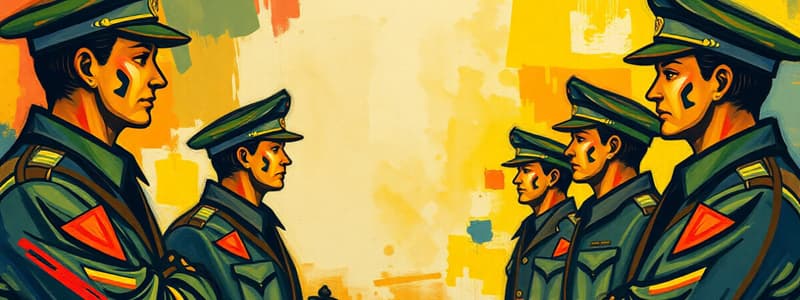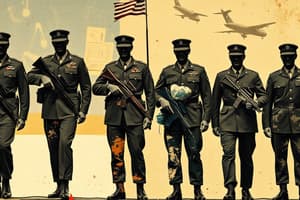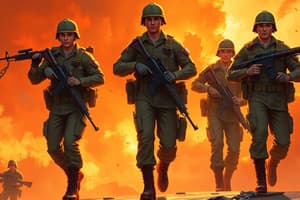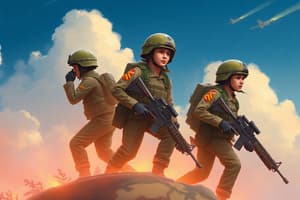Podcast
Questions and Answers
What is defined as 'the art and science of motivating, influencing, and directing Airmen'?
What is defined as 'the art and science of motivating, influencing, and directing Airmen'?
- Leadership (correct)
- Management
- Supervision
- Administration
What are leaders expected to ensure within a military organization?
What are leaders expected to ensure within a military organization?
- Personal recognition
- Organizational effectiveness and success (correct)
- Their own promotion
- Increased salaries
Which of the following is NOT considered a characteristic of effective leadership?
Which of the following is NOT considered a characteristic of effective leadership?
- Undivided focus on personal success (correct)
- Ability to command
- Emotional intelligence
- Understanding subordinates
Which value emphasizes excellence in both personal and collective efforts?
Which value emphasizes excellence in both personal and collective efforts?
What role do NCOs primarily serve in a military setting?
What role do NCOs primarily serve in a military setting?
How can developing your leadership philosophy be made easier?
How can developing your leadership philosophy be made easier?
What is a fundamental concept leaders must always remember?
What is a fundamental concept leaders must always remember?
Which statement best describes a follower in a military context?
Which statement best describes a follower in a military context?
What is the lowest level of trust reflected in the RLAM?
What is the lowest level of trust reflected in the RLAM?
What must exist before a leader can accomplish routine business?
What must exist before a leader can accomplish routine business?
Which element in the RLAM indicates the foundation of trust?
Which element in the RLAM indicates the foundation of trust?
What is described as a byproduct of leadership and an enabler of leadership?
What is described as a byproduct of leadership and an enabler of leadership?
How is commitment defined in relation to leadership according to the RLAM?
How is commitment defined in relation to leadership according to the RLAM?
Which of the following is NOT a part of the definition of authority for a military leader?
Which of the following is NOT a part of the definition of authority for a military leader?
What must a leader do to earn the confidence of their people according to the RLAM?
What must a leader do to earn the confidence of their people according to the RLAM?
What represents the limits of what you are allowed to do as a leader?
What represents the limits of what you are allowed to do as a leader?
What is one effective way to help others adapt in a new environment?
What is one effective way to help others adapt in a new environment?
How can mentoring others benefit a leader?
How can mentoring others benefit a leader?
What is a key component of adaptability as mentioned in the content?
What is a key component of adaptability as mentioned in the content?
Which action can help build better networks and relationships?
Which action can help build better networks and relationships?
What should a leader pay attention to beyond work?
What should a leader pay attention to beyond work?
What is the primary difference between 'competence' and 'competency'?
What is the primary difference between 'competence' and 'competency'?
What happens when the required competency exceeds your current competence?
What happens when the required competency exceeds your current competence?
How can character be metaphorically understood?
How can character be metaphorically understood?
What crucial aspect defines your character according to the provided content?
What crucial aspect defines your character according to the provided content?
Which statement correctly reflects the nature of personality in leadership?
Which statement correctly reflects the nature of personality in leadership?
Which definition captures the essence of character as described in the content?
Which definition captures the essence of character as described in the content?
What are the main influences on personality as stated in the content?
What are the main influences on personality as stated in the content?
What is necessary for a leader to maintain strong character?
What is necessary for a leader to maintain strong character?
What is the significance of people-relevance in leadership?
What is the significance of people-relevance in leadership?
What risk do leaders face if they cannot fit within the organizational culture?
What risk do leaders face if they cannot fit within the organizational culture?
What should be the starting point for self-improvement according to the RLAM model?
What should be the starting point for self-improvement according to the RLAM model?
Which of the following is NOT a part of building trust as a leader?
Which of the following is NOT a part of building trust as a leader?
Which trait is essential for a leader to maintain their right to lead?
Which trait is essential for a leader to maintain their right to lead?
What is one way leaders can enhance their relevance in their field?
What is one way leaders can enhance their relevance in their field?
What does RLAM stand for in the context of leadership development?
What does RLAM stand for in the context of leadership development?
Which element should leaders focus on to ensure they remain effective in their roles?
Which element should leaders focus on to ensure they remain effective in their roles?
What is essential for a leader to maintain professionalism in their role?
What is essential for a leader to maintain professionalism in their role?
What does dispositional flexibility in leadership primarily include?
What does dispositional flexibility in leadership primarily include?
What is a key characteristic of leaders who practice dispositional flexibility?
What is a key characteristic of leaders who practice dispositional flexibility?
In handling negative emotions, how should a supervisor respond?
In handling negative emotions, how should a supervisor respond?
Effective communication from a dispositional flexibility leader should be characterized by which of the following?
Effective communication from a dispositional flexibility leader should be characterized by which of the following?
What approach should leaders take towards change, according to the concept of dispositional flexibility?
What approach should leaders take towards change, according to the concept of dispositional flexibility?
What should leaders do when they recognize contributions from team members?
What should leaders do when they recognize contributions from team members?
Which factor is NOT essential for a leader to exhibit dispositional flexibility?
Which factor is NOT essential for a leader to exhibit dispositional flexibility?
Flashcards
What is leadership?
What is leadership?
The art and science of motivating, influencing, and directing individuals to achieve a shared goal.
What are the two key concepts of effective leadership?
What are the two key concepts of effective leadership?
Ensuring the organization accomplishes its mission and supporting subordinates.
What's the primary role of leadership in an organization?
What's the primary role of leadership in an organization?
The leader's ability to influence followers to understand and contribute to achieving the mission.
How do NCOs contribute to unit effectiveness?
How do NCOs contribute to unit effectiveness?
Signup and view all the flashcards
Why is understanding the impact of leadership actions crucial?
Why is understanding the impact of leadership actions crucial?
Signup and view all the flashcards
What do good leaders and followers have in common?
What do good leaders and followers have in common?
Signup and view all the flashcards
What is emotional intelligence and why is it important for leaders?
What is emotional intelligence and why is it important for leaders?
Signup and view all the flashcards
What is the core value of "Excellence in All We Do" and how does it relate to leadership?
What is the core value of "Excellence in All We Do" and how does it relate to leadership?
Signup and view all the flashcards
Competency
Competency
Signup and view all the flashcards
Competence
Competence
Signup and view all the flashcards
Character
Character
Signup and view all the flashcards
Character (USAF Academy Definition)
Character (USAF Academy Definition)
Signup and view all the flashcards
Personality
Personality
Signup and view all the flashcards
Competent
Competent
Signup and view all the flashcards
Not Yet Competent
Not Yet Competent
Signup and view all the flashcards
Skill Development
Skill Development
Signup and view all the flashcards
Respect (Trust Level)
Respect (Trust Level)
Signup and view all the flashcards
Confidence (Trust Level)
Confidence (Trust Level)
Signup and view all the flashcards
Commitment (Trust Level)
Commitment (Trust Level)
Signup and view all the flashcards
Trust is Fragile
Trust is Fragile
Signup and view all the flashcards
Speed of Trust Principle
Speed of Trust Principle
Signup and view all the flashcards
Military Leader's Authority
Military Leader's Authority
Signup and view all the flashcards
Limits of Authority
Limits of Authority
Signup and view all the flashcards
Respect vs. Trust
Respect vs. Trust
Signup and view all the flashcards
Adaptability
Adaptability
Signup and view all the flashcards
Organizational Relevance
Organizational Relevance
Signup and view all the flashcards
People Relevance
People Relevance
Signup and view all the flashcards
Relevance, Leadership, and Adaptability Model (RLAM)
Relevance, Leadership, and Adaptability Model (RLAM)
Signup and view all the flashcards
Emotional Intelligence (EQ)
Emotional Intelligence (EQ)
Signup and view all the flashcards
Rehearse
Rehearse
Signup and view all the flashcards
Embrace Change
Embrace Change
Signup and view all the flashcards
Emotional Flexibility
Emotional Flexibility
Signup and view all the flashcards
Mentoring as Leadership
Mentoring as Leadership
Signup and view all the flashcards
Dispositional Flexibility
Dispositional Flexibility
Signup and view all the flashcards
Change as an opportunity
Change as an opportunity
Signup and view all the flashcards
Encouraging Change
Encouraging Change
Signup and view all the flashcards
Self-Awareness and Adaptability
Self-Awareness and Adaptability
Signup and view all the flashcards
Effective Communication with Dispositional Flexibility
Effective Communication with Dispositional Flexibility
Signup and view all the flashcards
Dispositional Flexibility and Hope
Dispositional Flexibility and Hope
Signup and view all the flashcards
Inclusivity in Dispositional Flexibility
Inclusivity in Dispositional Flexibility
Signup and view all the flashcards
Embracing Uncertainty
Embracing Uncertainty
Signup and view all the flashcards
Study Notes
Defining Leadership
- Air Force Doctrine defines leadership as the art and science of motivating, influencing, and directing Airmen to accomplish the Air Force mission.
- Effective leaders prioritize the mission and their subordinates.
- Unit effectiveness depends on a leader's ability to lead people towards accomplishing the mission.
- Leaders must understand that all actions and communication send messages to followers.
- Leadership requires emotional intelligence and understanding of subordinates.
Defining Followership
- A follower is one who serves another, follows another's opinions or teachings, or imitates another.
- Key to followership is understanding expectations and the mission.
- Successful followers are committed to the organizational plan and concur with its goals.
- Good leaders create an environment where followers want to follow them.
Types of Leadership
Autocratic Leadership
- Leader holds all authority, control, and responsibility.
- Decisions made unilaterally without input from subordinates.
- Communication flows downward, expecting prompt implementation.
- Little flexibility in the work environment.
Democratic Leadership
- Involves subordinates in decision-making.
- Leader holds final responsibility but delegates authority.
- Focuses on subordinate contributions.
- Communication flows actively both upward and downward.
Strategic Leadership
- Prioritizes organizational success over personal status.
- Takes responsibility for outcomes.
- Role model - Demonstrating teamwork spirit.
Transformational Leadership
- Initiates change in organizations, groups, oneself, and others.
- Motivates to achieve beyond original expectations.
- Focuses on individual advancement and organizational change.
Team Leadership
- Creates a compelling vision for the team's future.
- Manages personal dynamics within smaller teams.
- Focuses on leveraging individual strengths and weaknesses.
- Ensures team members stay on track with goals.
Cross-Cultural Leadership
- Focuses on integrating different types of people and providing equal opportunities.
- Empathetic understanding of various perspectives.
Charismatic Leadership
- Inspires trust and confidence through charm and credibility.
- Motivates change by inspiring trust and credibility.
- Draws on past experience as a guide.
Visionary Leadership
- Implements change with strong willpower and ideas.
- Drives change by identifying skill sets and implementing change.
- Challenges standard procedure, not just by words but deeds.
Coaching Leadership
- Develops individuals through genuine encouragement.
- Focuses on member’s skill improvement and success.
Transactional Leadership
- Leader's make exchanges using "You do this and I'll reward you."
- Sets clear expectations with defined outcomes..
- Leaders are focused on meeting objectives and task completion.
Laissez-faire Leadership
- Leader is absent from projects and doesn't provide guidance or direction.
- Subordinates are left to figure things out independently.
Facilitative Leadership
- Prioritizes group collaboration and objectives.
- Leverages collective input to improve productivity.
- Focuses on collective group success.
Leadership Model (RLAM)
- This model helps individuals reflect on and structure their approach to leadership.
- Components include Reputation & Trust, Authority, Obligations & Requirements, Competence, Character, Personality and Relevance
- Leadership is comprised of elements that help leaders motivate and understand others through a better understanding of themselves and the world around them.
Adaptability
- Adaptability is the ability to adjust to changed, unexpected, ambiguous situations.
- Elements of adaptability include cognitive flexibility, emotional flexibility, and dispositional flexibility.
Studying That Suits You
Use AI to generate personalized quizzes and flashcards to suit your learning preferences.




